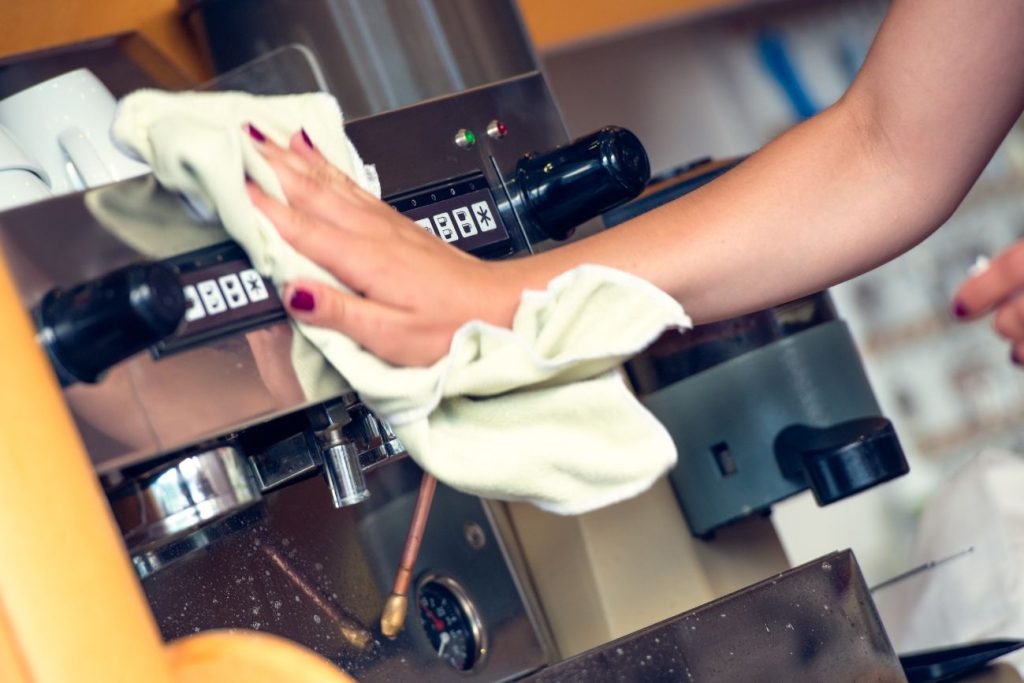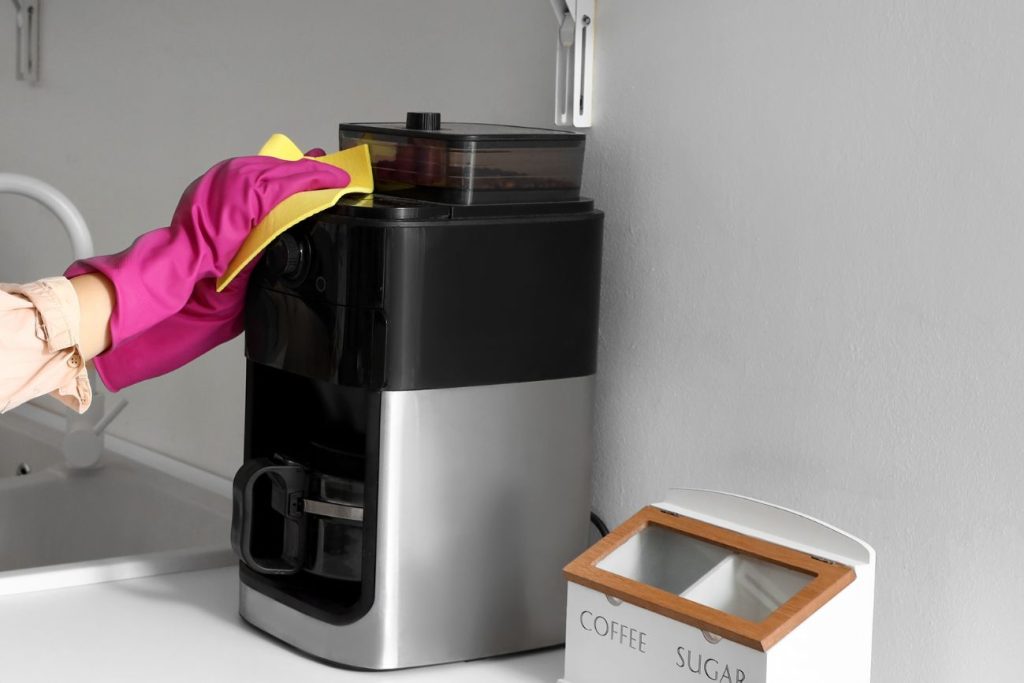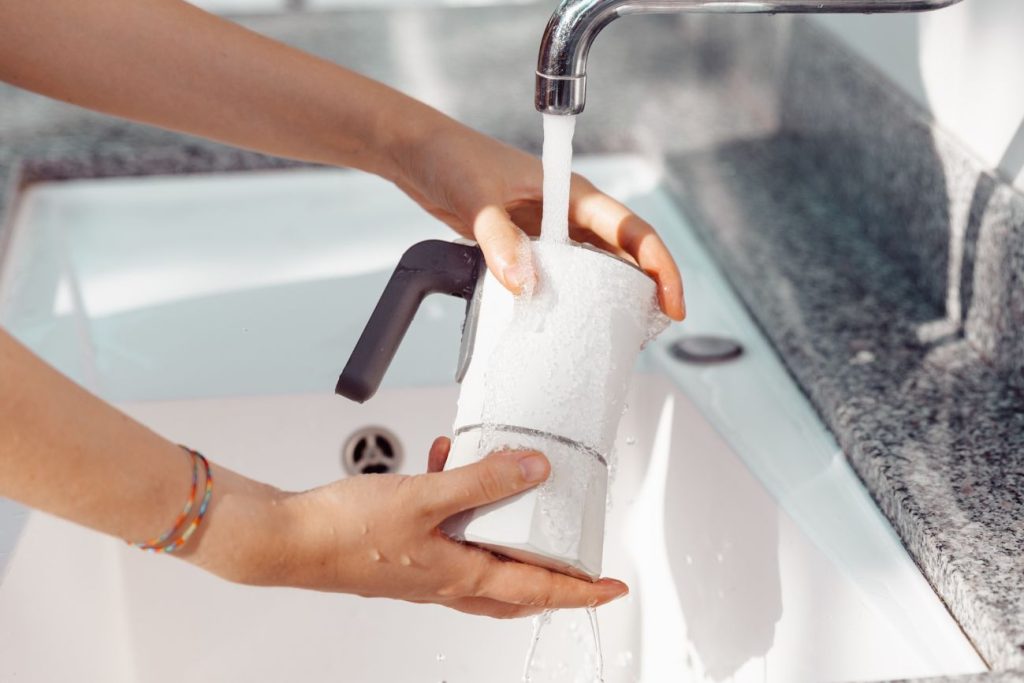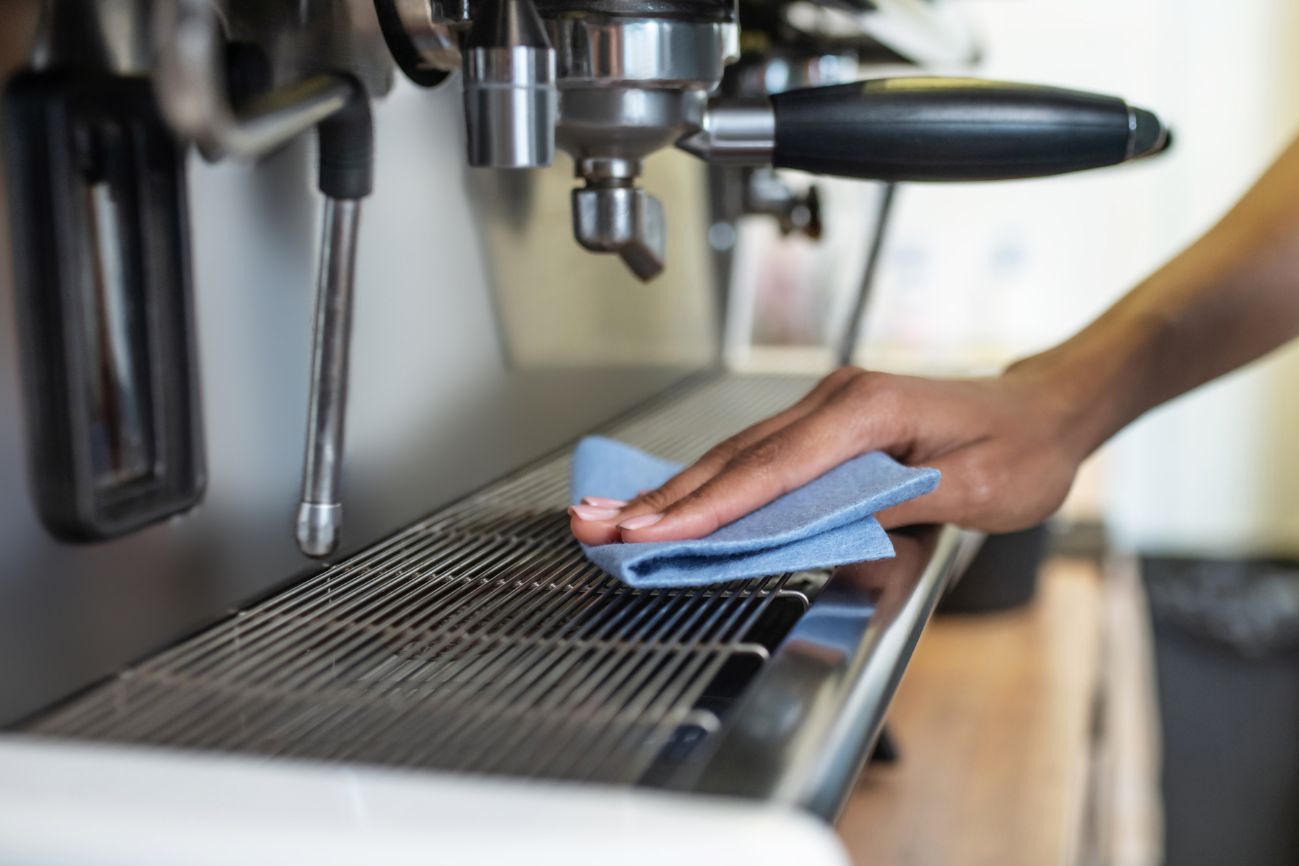To truly enjoy a delicious cup of coffee, you need to know how to clean coffee maker properly.
One thing is certain, the coffee must be on point in terms of aroma, brew strength, and balanced flavor. For a coffee aficionado, drinking a bitter and unsatisfactory cup in the morning is disappointing. That is why cleaning your coffee maker is necessary to cherish fresh and tasty coffee.
Otherwise, oils, coffee residue, bacteria, and mineral deposits can build over time, making your coffee taste bitter and impacting your machine’s performance.
In this blog post, we have covered everything about how to clean a coffee maker. Keep reading till the end to get all the insights.
Why Cleaning Your Coffee Maker Matters
Did you know that, according to the NSF (National Sanitation Foundation) Household Germ Study, nearly 50% of coffee makers tested had bacteria and molds on them, still many neglect regular coffee maker maintenance. Over time, coffee oils, mineral deposits, and remaining ground particles deposit on your coffee maker which are responsible for:
- A bad coffee taste.
- Decreased efficiency of the machine.
- Mould and bacteria growth like E-coli.
A poorly managed and stained coffee maker not only makes your coffee taste bitter but also damages your health. Cleaning your coffee maker is a breeze. It can be done without any hassle by following some simple steps.
How Often Clean Coffee Maker?
Cleaning your coffee maker doesn’t have to be a daunting task. By sticking to a regular schedule, you can keep your machine in top condition. Here’s a simple guideline:
- Daily: Empty coffee grounds, rinse the carafe and filter basket, and wipe down the exterior.
- Weekly: Deep clean removable parts with warm, soapy water.
- Monthly: Descale the machine using natural or commercial cleaners.
Essential Supplies to Clean Coffee Maker

Keeping your clean coffee machine is key for a fresh cup of coffee. You’ll need some important items to descale the coffee maker naturally. Let’s look at what you need to keep your machine working well.
| Cleaning Supply | Purpose |
| White vinegar | Removes mineral deposits and coffee oils |
| Lemon juice or citric acid | Natural descaling agent |
| Baking soda | Gentle abrasive for scrubbing |
| Soft-bristled brush/sponge | Aids cleaning the stained areas |
| A Microfiber cloth | Wipes down the exterior for a streak-free shine |
| Commercial coffee maker cleaner | Specialized solution for deep cleaning |
With these supplies, you can clean your coffee machine well. You’ll get a bitter-free brew every time.
Step-by-Step Guide: How to Clean Coffee Maker
Step 1: Powering Off the Coffee Maker
To ensure safety, always power off your coffee maker and cool in down before cleaning.
Step 2: Tossing Out the Used Coffee Grounds
Empty the filter basket and discard any used coffee grounds.
Step 3: Wash Removable Parts
Clean the carafe, basket, and other detachable parts with moderately warm water. Rinse thoroughly.
Step 4: Prepare a Cleaning Solution
Fill the water reservoir halfway with warm water and white vinegar. This mixture helps dissolve residue and mineral buildup.
Step 5: Run a Brew Cycle
Pour the vinegar solution into the water reservoir. Start a brewing cycle and pause halfway through to let the solution sit for 15–20 minutes.
Step 6: Finish and Rinse Thoroughly
After the cycle finishes, run another cycle with ordinary water to wash out the vinegar.
Step 7: Wipe Down the Machine
Use a damp microfiber cloth to wipe down the exterior, removing any stains or fingerprints.
Step 8: Air Dry Completely
Use dry air to dehydrate the all parts completely before reassembling
Pro Tip: Proper and regular cleaning (every 1–2 months for the best results) will significantly improve the taste of your brew. Do not forget to avoid mixing household cleaning products, as these mixtures release harmful chemicals.
Cleaning for Specific Coffee Makers
How to Clean a Drip Coffee Maker

Regular cleaning can extend the life of your drip coffee maker. Follow the steps below:
Step 1
- Use a moderately wet cloth to clean the interior of the chamber.
- Use a brush, for instance grout brush, for confined spaces.
Step 2
- Fill the water chamber with white vinegar and water in equal proportion.
- Remove all the leftovers.
- Add a paper filter to catch deposits, brew half the mixture, then turn off the machine.
- Let it soak for 30–60 minutes.
Step 3
- Brew the remaining vinegar-water mixture.
- Replace the filter, rinse the chamber with clean water, and run two full brewing cycles.
Step 4
- Clean the carafe with moderately warm water and dish soap using a dishcloth.
- Remove dust and oil from the coffee machine.
Step 5
- Use a descaling product for stubborn limescale or calcium deposits.
- Use filtered water to prevent future buildup.
How to Clean a Single-Cup Coffee Maker
Single-cup machines are quick and convenient. Most manufacturers recommend descaling every 3–6 months.
Step 1
- Empty the coffee maker and ensure no pod is inside.
Step 2
- Mix white vinegar half cup and water one cup precisely.
- Add the mixture into the tank, while pouring make sure that the pod area is empty.
Step 3
- Start the coffee maker and prepare a cup of coffee by brewing.
- Turn off the machine and let the vinegar solution sit for 15 minutes.
Step 4
- Use water (brew 2 cycles) to remove the vinegar taste.
- Turn off the machine for 15 minutes between each cycle.
Pro Tips:
- Empty and refill the water reservoir daily.
- Use filtered water to minimize hard water deposits.
- Wipe the machine’s exterior regularly.
- Allow the machine to air dry between uses.
How to Clean a Glass Pour-Over Coffee Maker
Cleaning a glass pour-over coffee maker can be tricky since your hand cannot fit inside. This method can be done after each use, but if rinsed well between uses, cleaning twice a month is sufficient.
Step 1
- Fill the bottom of the coffee maker with a handful of ice cubes or a cup of crushed ice (use less if the machine is small).
Step 2
- Add 4 tablespoons of table salt, 1 tablespoon of water, and 1 tablespoon of citric acid.
- Swirl the mixture vigorously so the salty ice cleans the dried coffee sludge without scratching the glass.
Step 3
- Put ice and salted water, then rinse the coffee maker thoroughly with cold water.
- Avoid hot water, as it can crack the cold glass.
Pro Tip:
If debris still exists, iterate the process or use a Chemex brush. You may use any long-handled brush with dish soap to clean.
How To Clean an AeroPress
For fast brewing time and low-acidity coffee, AeroPress is among the top choices. You can clean the AeroPress coffee maker using the following steps.
Step 1
- After each use, untwist the cap and press the AeroPress and wait for the filter and grounds to come out.
Step 2
- Wash out the AeroPress thoroughly, pay detailed attention to the sealed rubber present on the plunger
Step 3
- If debris persists, with due care scrub the interior with a brush and dish soap.
- The AeroPress is also top-shelf dishwasher safe.
How To Descale a Coffee Maker Naturally
Minerals present in the hard water gradually deposit on your machine. It results in the blockage of the coffee machine. Here’s how to descale it naturally:

- Mixing the Solution: Combine proportion of white vinegar and water equally.
- Soak and Brew: Run a brew cycle, pause halfway, and let it sit for 30 minutes.
- Rinse Continuously: Use water (brew 2 cycles) to get rid of the vinegar taste
Pro Tip: For those who live in those places where soft water is not available. You should have to descale your machine almost every two months for the best results.
Natural Vs. Commercial Methods
If you want to drink excellent coffee, start caring for your coffee maker. Let’s look at their plus points and negative points.
Vinegar Solution Method
A Vinegar and water mixture is a popular natural cleaner. White vinegar’s acid breaks down buildup and oils. Mix solution containing water and vinegar in equal proportion to start a cycle.
This method is cheap and easy on your machine.
Citric Acid Cleaning
Citric acid is another natural choice. You can find it as powder or lemon juice. It dissolves deposits and residues like vinegar does.
Add 1-2 tablespoons of powder or lemon juice to water. Then, run a cycle.
Commercial Descaling Products
You can use commercial products to descale coffee makers and prevent bitter coffee taste. They have stronger acids to remove buildup. But they cost more and need careful use.
Choosing between natural vs. commercial cleaners is totally up to you. Think about cost, preference, and buildup level. Your coffee maker keeps on working well if you regularly descale it.
A quick comparison table: Natural vs Commercial descalers
| Cleaning Method | Effectiveness | Ease of Use | Cost |
| Vinegar Solution | Moderate | Easy | Low |
| Citric Acid | High | Moderate | Moderate |
| Commercial Descaler | High | Easy | Moderate to High |
Tips to Keep Your Coffee Maker Fresh
1. Use Filtered Water
Hard water contributes to mineral buildup. Filtered water improves the coffee flavor and reduces scaling of the maker
2. Empty the Carafe Immediately
It is important to clean the carafe regularly. Un-attended carafe is the root cause of stains and a foul odor. Discard leftover coffee immediately after brewing.
3. Clean the Grinder
Regular cleaning of your coffee grinder is essential, mostly for those who have inbuilt grinder. This will not allow old coffee to mix with the fresh coffee.
4. Replace Filters Regularly
Reusable filters should be cleaned thoroughly after each use. After each brew, you should replace the paper filters.
Explore our guide on Coffee Brewing Methods for Every Taste to discover the perfect way to brew your coffee.
Final Thought
To wrap up, how to clean your coffee maker is no longer a mystery. We have unveiled every bit and piece of detail related to your coffee maker maintenance. Now you can not only enjoy coffee that is sumptuous and healthy but also help your coffee maker last longer.
Go, and grab your coffee maker if it needs cleaning. This way, you’ll enjoy your coffee in a new way. Follow the fresh-tasting coffee tips and the coffee maker cleaning steps in this article. Take the time to clean your coffee maker and savor the difference in every brew.
FAQs About Cleaning A Coffee Maker
Q. Is there any alternative for descaling solution?
A. Baking soda is the alternative. It is less costly natural cleaner, whitener, and descaler. Baking soda is ideal for removing stains. Also, it removes buildup without leaving an undesirable aftertaste.
Q. Can I drink coffee immediately after descaling?
A. Absolutely, even if some coffee machine descaler is left in the water system, it causes no harm to the human body and doesn’t affect the flavor of your coffee.
Q. What is a natural descaler?
A. Distilled white vinegar and water method is natural.
Q. Is descaling solution better than the vinegar?
A. There are positive and negatives to both vinegar and commercial descaling solutions. If; however, effectiveness is your priority, then you should go with commercial solution.
Q. Is baking soda clean my coffee machine?
A. Yes. Baking soda washes, scrubs and removes stains deposited on your coffee pot. It is effective due to its cleaning and odor-neutralizing properties.
Q. Can I use lemon juice be used descale my coffee machine?
A. Yes, citric acid can be used to descale your coffee machines. It’s not as acidic as commercial descaling methods so you may need to repeat the descaling process more than once.
Q. What is the best household descaler?
A. Vinegar is one of the best natural descalers in your kitchen. Vinegar is very acidic that combats the limescale of your coffee appliance after regular brewing.




